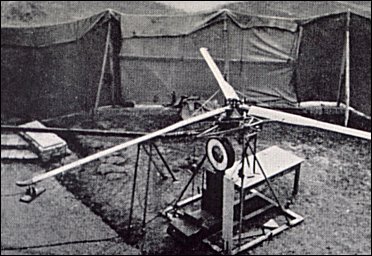
| Doblhoff WNF-342 V1 1958 |  |
 |

| Doblhoff WNF-342 V1 1958 |  |
 |
|
First helicopter in the world to take off and land using blade-tip jets to drive the rotor, the WNF-342 was the work of three engineers - Friedrich von Doblhoff, A.Stepan and Theodor Laufer - at the Wiener Neustadter Flugzeugwerke in Vienna. Doblhoff first built, in 1942, a ground test rig to prove the principle of his proposed rotor drive system, this rig consisting basically of a trio of hollow rotor blades mounted on a scaffold with the fuel/air mixture fed through each blade to a small jet unit at the tip. The demonstration proved so successful that the rotor actually 'took off' from its moorings, lifting about a yard into the air an anvil that had been attached to it to hold it down. Encouraged by this success, Doblhoff and his team then applied the principle in the small single-seat WNF-342V1 which he hoped would meet a German Navy requirement for an observation helicopter to be carried by submarines or small naval vessels. This first prototype, powered by a 60hp Walter Mikron II engine, was flown in spring 1943. The airframe, constructed from welded steel tube and fabric covered, had a gross weight of 360kg, twin tail fins and a tricycle undercarriage. Flight testing revealed the need for rather more side area, but performance was otherwise satisfactory, and when the WNF factory was damaged during an Allied air attack in mid-August 1943 the aircraft was moved to a safer site west of Vienna, at Obergraffendorf. Here a second machine, the WNF-342 V2, was built, being a somewhat heavier aircraft at 460kg gross weight, despite its open-framework fuselage K.Munson "Helicopters And Other Rotorcraft Since 1907", 1968
From 1942 onwards Doblhoff began investigating the application of the jet principle to helicopters at the Wiener Neustadter Flugzeugwerke. A conventional piston engine drove a compressor, in this particular case the supercharger blower of an Argus 411 engine. The mass flow of compressed air produced by this blower was mixed with fuel before passing through the hollow rotor blades to chrome steel combustion chambers situated at the blade tips. Combustion of this fuel-air mixture occurred at a rate of approximately 280 times per second. Because of their very high consumption, these jets were used only for take-off, hovering and landing. In normal flight, the piston engine of the Doblhoff III and IV, which otherwise drove the compressor, was then clutched with an airscrew. When the jets were not working, the blades turned by auto-rotation and the aircraft behaved exactly like an autogyro. Doblhoff designed the first helicopter in the world to take off by the use of jets. After World War II, Doblhoff emigrated to the United States, where he collaborated in the development of the McDonnell compound helicopter. Of the other members of his team, Laufer went to France after the war and joined SNCASO, where he worked on the jet-propelled Djinn, and Stepan went to England, where he joined Fairey and also does work connected with jet-propelled rotary wings. Doblhoff WNF 342 V1 Work was started by carrying out tests with hollow-bladed rotors placed on top of a light alloy scaffolding. A compressed air tube entered the rotor hub, and vaporized petrol was added by special tubing. The mixture was ignited at the blade tip by an automobile sparking plug. The effectiveness of the principle was dramatically proved: the rotor flew away with the attachment which held it on to the light alloy scaffolding. Doblhoff then set about building his first proto-type, which first flew in the spring of 1943. A 60hp engine drove the compressor which supplied the compressed air, and the rotor was fitted with flapping and drag hinges. P.Lambermont "Helicopters and Autogyros of the World", 1958
|